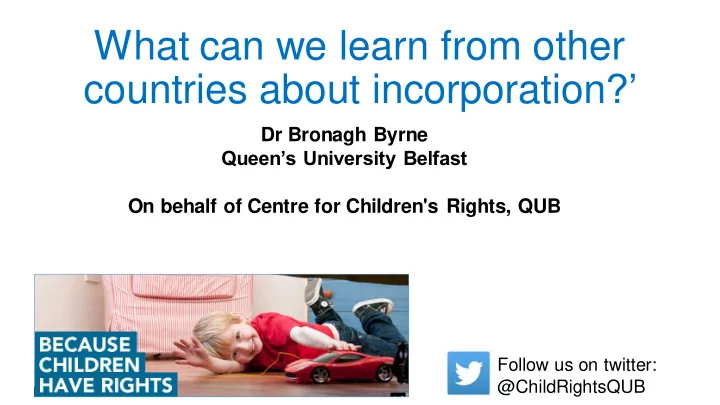

What can we learn from other countries about incorporation ?’ Dr Bronagh Byrne Queen’s University Belfast On behalf of Centre for Children's Rights, QUB Follow us on twitter: @ChildRightsQUB
Overview • ‘The UN Convention on the Rights of the Child: a study of legal implementation in twelve countries’ • Conducted for UNICEF-UK by Laura Lundy, Ursula Kilkelly, Bronagh Byrne and Jason Kang, The Centre for Children’s Rights, Queen’s University, Belfast www.qub.ac.uk/ccr • Aim: ‘… to research legislative examples of implementing the UNCRC in countries beyond the UK in order to compile evidence of the most effective, practical and impactful ways of embedding children’s rights into domestic law.’
Methods 1. Review of literature on UNCRC treaty implementation 2. Desk research on 12 countries Australia; Belgium; Canada; Denmark; Germany; Iceland; Ireland; New Zealand; Norway; South Africa; Spain; Sweden. 3. In-depth case studies of 6 countries, including field visits. Australia; Belgium; Germany; Ireland; Norway; Spain
Implementation of the UNCRC States Parties must ‘ undertake all appropriate legislative, administrative, and other measures for the implementation of the rights recognized in the present Convention. Article 4 UNCRC
General Measures of Implementation • Incorporation • Integration in domestic law • Independent human rights institutions • National children’s plans • Training and awareness • Child impact assessment • Child budgeting • Child data • Participation and engagement. Committee on the Rights of the Child, General Comment No. 5.
Findings
Incorporation dependent upon: • First and foremost by the constitutional and legal systems of individual countries. Also impacted upon by: • Political and public attitudes to international human rights law; • Political will/context; • Extent to which there is a pre-existing human rights culture; • Levels of awareness and training; • Levels of coordination within government and between NGOs and governments.
Full Incorporation
Partial Incorporation
Impact of Incorporation • Interviewees were more likely to say that children were perceived as rights-holders and that there was a culture of respect for children’s rights. • Provided leverage for politicians, civil servants, lawyers and NGOs to ensure integration of the principles in domestic law and policy. • Justicability varies but incorporation provides potential for using children’s rights in litigation • In many countries, certain areas or regions were identified as being at the forefront of the implementation of the CRC (such as Victoria in Australia, Catalonia in Spain, Berlin in Germany and, in different respects, the Flemish and French Communities in Belgium). This was thought to have a positive effect on others.
Summary • No one right way to proceed. • The process of incorporation (which raises awareness and can be accompanied by systematic training of decision-makers) and the result (where the CRC becomes internalised in the national level system) have significant value in ‘bringing rights home’ to children and to duty -bearers. • When the principles are integrated in domestic law the CRC starts to infuse decision-making in relation to children • Must be underpinned by systematic children’s rights training and a robust infrastructure designed to monitor, support and enforce implementation.
References Lundy, L., Kilkelly, U., Byrne, B. and Kang, J. (2012) The UN Convention on the Rights of the Child: a study of legal implementation in twelve countries ’ UNICEF UK. Lundy, L., Kilkelly, U., and Byrne, B. (2013 ) Incorporation of the United Nations Convention on the Rights of the Child in Law: A Comparative Review , International Journal of Children’s Rights, 21, p442 -463. Centre for Children’s Rights, Queen’s University Belfast www.qub.ac.uk/ccr Email: b.byrne@qub.ack
Recommend
More recommend